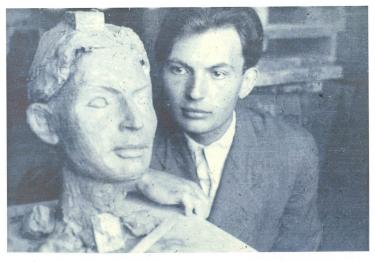Dr. Frinta found redeeming beauty midst devastation
ALTAMONT — Born in Prague in 1922, Mojmir Frinta, since his early school years, wanted to be a painter. The war got in the way.
After World War II, Dr. Frinta hitchhiked around Europe and saw the terrible devastation.
But he also went into the churches and saw “the redeeming beauty of the art made by humans, the goodness and hope of being human,” says his daughter, Dagmar Frinta.
Dr. Frinta spent the better part of a lifetime restoring, researching, and teaching about that art. He was a world-renowned scholar on medieval painting and sculpture, publishing scores of articles and two books.
Dr. Frinta died last week, on Wednesday, Jan. 21, with his third book finished but not yet published; his three children hope to see it printed. He was 92.
Dr. Frinta’s sons, Daniel and Richard, both are involved in photography and his daughter is involved in art education.
An artist and an art restorer
Born on July 28, 1922, Mojmir Frinta was the son of Antonin Frinta, a founding member of The Prague Linguistic Circle, and Jarmila Skopek, who, like her husband, had studied at the Sorbonne and valued education.
They raised their two sons, Mojmir and Jeronym, in Vinohrady, a Prague neighborhood known “for its professors and thinkers,” said Dagmar Frinta.
“As a child, he and his brother read books about Native Americans. He played the Indian scout,” she said. Later, after Dr. Frinta moved to Altamont, he was intrigued with the Indian Ladder Trail, she said.
“To him, they were brave and protected nature,” she said.
Once Dr. Frinta earned his baccalaureate degree, he enrolled at the College of Fine and Applied Arts in Prague. After the liberation in 1945, he studied both art history and art, winning a fellowship to study in Paris.
Dr. Frinta and the woman who would become his wife, Irena Altmanova, were both artists, studying first in Czechoslovakia and then in Paris. Dr. Frinta also worked as an art restorer for two-and-a-half years in Paris.
The Frintas married in Paris in 1948 as their families urged them not to return to the political upheaval at home.
“The Iron Curtain fell,” said Dagmar Frinta. She went on, about her parents, “They were dreamers and saw America on the horizon.”
The couple, sponsored by a distant cousin in Michigan, emigrated in 1951 to the United States. Dr. Frinta continued his studies in printmaking and earned a Ph.D. in art history from the University of Michigan at Ann Arbor.

Dr. Frinta became a staff member at the Metropolitan Museum of Art in New York City in 1955 and, because he specialized in medieval art, he was associated with the Medieval Department and The Cloisters as a senior restorer.
“He combined to an unusual degree the manual skills needed for restoration work, an excellent education in the history of art…and an intellectual capacity for research,” write Lucretia Kargere and Michele Marincola in their overview on the conservation of polychrome wood sculpture.
The authors go on to cite his training in “the renowned studio of Chaffrey-Muller in Paris” and say he combined his traditional training with scientific investigation, using such techniques as X-ray radiography to make discoveries.
Dr. Frinta was ahead of his time in leaving parts of medieval artworks untouched. “Frinta experimented with alternatives to imitative retouching and left areas of loss on The Cloisters Lamentation readily distinguishable from the original,” the authors write.
“Being an artist himself,” said Dagmar Frinta, “He knew the integrity of a work. He didn’t want to be false.” She also said that he had the mind of a scientist, which allowed him to make discoveries.
One discovery that Dr. Frinta made at The Cloisters, said Daniel Frinta, was the uncovering of an important section of a work that had been over painted.
“He was so passionate,” said Richard Frinta, describing his father’s relationship to his work.
Altamont years: Teaching and travels
The Frintas moved to Altamont in 1963, said Daniel Frinta, the oldest of the three siblings; he was 11 at the time. “We could ride our bikes here,” he said.
The family first rented an apartment and then bought a Victorian house on Maple Avenue.
Their next-door neighbors for many years have been Mayor James Gaughan and Keith Lee. “Keith and I are very saddened by the passing of Mr. Frinta, our esteemed next-door neighbor and community friend for over 30 years,” the mayor said this week. “He played a key role as professor at the New York State University…renowned as a medieval and Byzantine art expert and connoisseur.
“It was not unusual to see him sitting at the window in his study assiduously scouring his manuscripts for hours at a time. Little would anyone know that this unassuming gentleman was such an erudite scholar and renowned expert in his field.”
Dr. Frinta was an art historian at the University at Albany. He became an associate professor in 1965 and a professor in 1969. After 30 years of teaching, he became a professor emeritus in 1993.
He was involved in starting a slide library. Among his students were Michael Oatman, now at RPI, and Ken Johnson, an art critic for The New York Times.
Daniel Frinta said he sat in on some of his father’s classes and noted, “He always had a good sense of humor.”
Dr. Frinta spoke Czech, English, French, German, and Italian; also, he could read Latin, Spanish, and Slavic languages.
There was a strong nucleus of “father figures” in Altamont as they were growing up, his children said — this included Bill Rowley, a newspaperman who started the journalism department at the University of Albany; Ed Cowley, an artist who headed the art department at the University at Albany; Larry Warner, an Altamont mayor who worked at General Electric; Bill Aylward, a social studies teacher who served as village mayor, town supervisor, and county legislator; James “Keen”holts Hilton, St. John’s long-time pastor; and Eugene Lemmerman, a missionary and science teacher.
“They were complicated men — highly creative and idealistic — who cared about their families,” Dagmar Frinta said.
Richard Frinta described his parents’ marriage as one of “mutual support.” They were never competitive about their artwork, he said. “There was give and take, and the value of working together,” he said.
“My parents loved each other,” said Dagmar Frinta. She said of her father, “He did protect us…He took his vows seriously to love and protect.”
Despite the many long hours he spent in his study, Dr. Frinta also loved nature and being outdoors, his children said.
“He took us skiing up on the hill,” Richard Frinta said of the Helderbergs. Even when the family lived in New York City, Dr. Frinta would take them on park outings, they said. “It was not just the city and concrete,” said Richard Frinta.
The family also traveled extensively in Europe, including during two year-long sabbaticals for Dr. Frinta in Florence, Italy.
“We bonded the most when we were traveling,” said Daniel Frinta.
“He was very strongly tied to Europe,” said Dagmar Frinta. “He wanted us to know our heritage.”
Art became a part of all of their lives, and still is. Richard Frinta, a photographer, said of his art, “It’s something within you. It brings you joy to communicate feelings, emotions, good will.”
Much of the family’s travels centered on Dr. Frinta’s visits to sacred sites. The bulk of his research — collected in a hefty volume with thousands of pictures — is on the punched decoration of gilt surfaces in Italian panel paintings.
“He was a specialist in the punch marks of gilded halos of saints,” said his daughter.
Dr. Frinta could distinguish the different artists’ studios or ateliers, by their intricate marks — some of leaves, others of flowers, still others in geometric shapes.
He was assiduous and tireless in his research and travels. He recovered from quadruple bypass surgery in 2001 to pursue his work. “He had incredible spirit and a mind that helped him heal,” said his daughter. “He always bounced back.”
Daniel Frinta recalled a recent trip to a Greek island he took with his father where his father climbed a thousand steps to see a monastery. “He was a font of knowledge about everything we visited,” he said.
Even with his recent heart troubles, Richard Frinta said, “His mind was so clear.” At the time of his death, he was working to meet a deadline for publication.
“The editor in Belgium was expecting corrections,” said his daughter.
Life lessons
Richard Frinta said his father “had two strong spirits — the intellectual and the human spirit.” He went on, “He had a real appreciation for beauty, I try to look at everything to see how it could be beautiful. He’s always in my thought process, seeking truth and beauty.”
Daniel Frinta said, “He strongly pushed us all to go to college.”
All of his children described him as a conservationist, not just because he loved nature, but as an environmentalist who recycled ahead of his time.
“ My husband, Mojmir, and I were fortunate to have mutual interests in art and in our family, full support in daily living, faithful love for over 66 years,” said his wife, Irena Altmanova Frinta. “I will miss him.”
****
Mojmir Frinta is survived by his wife of 66 years, Irena, and by his children, Daniel, Dagmar, and Richard.
A memorial service will be held on Saturday, Jan. 31, at 2 p.m. at St. John’s Church at 140 Maple Ave. in Altamont. A meet-and-greet with family will precede the service at 1 p.m., and refreshments and fellowship will follow, from 3 to 4 p.m.
Memorial contributions may be made to St. John’s Evangelical Lutheran Church, 140 Maple Ave., Altamont, NY 12009.



